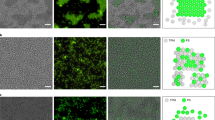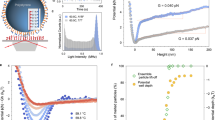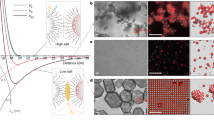Abstract
Colloids functionalized with DNA hold great promise as building blocks for complex self-assembling structures. However, the practical use of DNA-coated colloids (DNACCs) has been limited by the narrowness of the temperature window where the target structures are both thermodynamically stable and kinetically accessible1,2,3,4,5. Here we propose a strategy to design DNACCs, whereby the colloidal suspensions crystallize on cooling and then melt on further cooling. In a phase diagram with such a re-entrant melting, kinetic trapping of the system in non-target structures should be strongly suppressed. We present model calculations and simulations that show that real DNA sequences exist that should bestow this unusual phase behaviour on suitably functionalized colloidal suspensions. We present our results for binary systems, but the concepts that we develop apply to multicomponent systems and should therefore open the way towards the design of truly complex self-assembling colloidal structures.
This is a preview of subscription content, access via your institution
Access options
Subscribe to this journal
Receive 12 print issues and online access
$259.00 per year
only $21.58 per issue
Buy this article
- Purchase on Springer Link
- Instant access to full article PDF
Prices may be subject to local taxes which are calculated during checkout





Similar content being viewed by others
References
Milam, V. T., Hiddessen, A. L., Crocker, J. C., Graves, D. J. & Hammer, D. A. DNA-driven assembly of bidisperse, micron-sized colloids. Langmuir 19, 10317–10323 (2003).
Kim, A. J., Biancaniello, P. L. & Crocker, J. C. Engineering DNA-mediated colloidal crystallization. Langmuir 22, 1991–2001 (2006).
Nykypanchuk, D., Maye, M. M., van der Lelie, D. & Gang, O. DNA-guided crystallization of colloidal nanoparticles. Nature Mater. 451, 549–552 (2008).
Park, S. Y. et al. DNA-programmable nanoparticle crystallization. Nature Mater. 451, 553–556 (2008).
Nykypanchuk, D., Maye, M. M., van der Lelie, D. & Gang, O. DNA-based approach for interparticle interaction control. Langmuir 23, 6305–6314 (2007).
Mirkin, C. A., Letsinger, R. C., Mucic, R. C. & Storhoff, J. J. A DNA-based method for rationally assembling nanoparticles into macroscopic materials. Nature 382, 607–609 (1996).
Alivisatos, A. P. et al. Organization of ‘nanocrystal molecules’ using DNA. Nature 382, 609–611 (1996).
Mucic, R. C., Storhoff, J. J., Mirkin, C. A. & Letsinger, R. L. DNA-directed synthesis of binary nanoparticle network materials. J. Am. Chem. Soc. 120, 12674–12675 (1998).
Leunissen, M. E., Dreyfus, R., Sha, R., Seeman, N. C. & Chaikin, P. M. Quantitative study of the association thermodynamics and kinetics of DNA-coated particles for different functionalization schemes. J. Am. Chem. Soc. 132, 1903–1913 (2010).
Leunissen, M. E. et al. Switchable self-protected attractions in DNA-functionalized colloids. Nature Mater. 8, 590–595 (2009).
Xiong, H., van der Lelie, D. & Gang, O. Phase behavior of nanoparticles assembled by DNA linkers. Phys. Rev. Lett. 102, 015504 (2009).
Dreyfus, R. et al. Simple quantitative model for the reversible association of DNA coated colloids. Phys. Rev. Lett. 102, 048301 (2009).
Dreyfus, R. et al. Aggregation–disaggregation transition of DNA-coated colloids: Experiments and theory. Phys. Rev. E 81, 041404 (2010).
Jin, R., Wu, G., Li, Z., Mirkin, C. A. & Schatz, G. C. What controls the melting properties of DNA-linked gold nanoparticle assemblies? J. Am. Chem. Soc. 125, 1643–1654 (2003).
Leunissen, M. E. & Frenkel, D. Numerical study of DNA-functionalized microparticles and nanoparticles: Explicit pair potentials and their implications for phase behavior. J. Chem. Phys. 134, 084702 (2011).
Lukatsky, D. B. & Frenkel, D. Surface and bulk dissolution properties, and selectivity of DNA-linked nanoparticle assemblies. J. Chem. Phys. 122, 214904 (2005).
Biancaniello, P. L., Kim, A. J. & Crocker, J. C. Colloidal interactions and self-assembly using DNA hybridization. Phys. Rev. Lett. 94, 058302 (2005).
Mognetti, B., Leunissen, M. E. & Frenkel, D. Controlling the temperature sensitivity of DNA-mediated colloidal interactions through competing linkages. Soft Matter 8, 2213–2221 (2012).
Scarlett, R. T., Ung, M. T., Crocker, J. C. & Sinno, T. A mechanistic view of binary colloidal superlattice formation using DNA-directed interactions. Soft Matter 7, 1912–1925 (2011).
Starr, F. W. & Sciortino, F. Model for assembly and gelation of four-armed DNA dendrimers. J. Phys. Condens. Matter 18, L347 (2006).
Martinez-Veracoechea, F. J., Mladek, B. M., Tkachenko, A. V. & Frenkel, D. Design rule for colloidal crystals of DNA-functionalized particles. Phys. Rev. Lett. 107, 045902 (2011).
Mladek, B. M., Charbonneau, P., Likos, C. N., Frenkel, D. & Kahl, G. Multiple occupancy crystals formed by purely repulsive soft particles. J. Phys. Condens. Matter 20, 494245 (2008).
Wang, F. & Landau, D. P. Efficient, multiple-range random walk algorithm to calculate the density of states. Phys. Rev. Lett. 86, 2050–2053 (2001).
Abreu, C. R. A. & Escobedo, F. A. A general framework for non-Boltzmann Monte Carlo sampling. J. Chem. Phys. 124, 054116 (2006).
Lechner, W. & Dellago, C. Accurate determination of crystal structures based on averaged local bond order parameters. J. Chem. Phys. 129, 114707 (2008).
Markham, N. R. & Zuker, M. Dinamelt web server for nucleic acid melting prediction. Nucleic Acids Res. 33, W577–W581 (2005).
Acknowledgements
We thank P. Varilly, F. Martinez-Veracoechea and L. Fillion for useful discussions and a critical reading of the manuscript. This work was supported by the European Research Council (ERC) Advanced Grant 227758, the Wolfson Merit Award 2007/R3 of the Royal Society of London and the Engineering and Physical Sciences Research Council (EPSRC) Programme Grant EP/I001352/1.
Author information
Authors and Affiliations
Contributions
S.A-U. conceived the model, developed the analytical theory, performed the simulations and analysed the data. B.M.M. developed the analytical theory and analysed the data. D.F. initiated and supervised the research and analysed the data. All three authors contributed to writing the manuscript.
Corresponding author
Ethics declarations
Competing interests
The authors declare no competing financial interests.
Supplementary information
Supplementary Information
Supplementary Information (PDF 254 kb)
Rights and permissions
About this article
Cite this article
Angioletti-Uberti, S., Mognetti, B. & Frenkel, D. Re-entrant melting as a design principle for DNA-coated colloids. Nature Mater 11, 518–522 (2012). https://doi.org/10.1038/nmat3314
Received:
Accepted:
Published:
Issue Date:
DOI: https://doi.org/10.1038/nmat3314
This article is cited by
-
The influence of arm composition on the self-assembly of low-functionality telechelic star polymers in dilute solutions
Colloid and Polymer Science (2021)
-
Transient self-organisation of DNA coated colloids directed by enzymatic reactions
Scientific Reports (2019)
-
On the mechanism behind the inverse melting in systems with competing interactions
Scientific Reports (2019)
-
Crystal engineering with DNA
Nature Reviews Materials (2019)
-
DNA-Coated Microspheres and Their Colloidal Superstructures
Macromolecular Research (2018)



